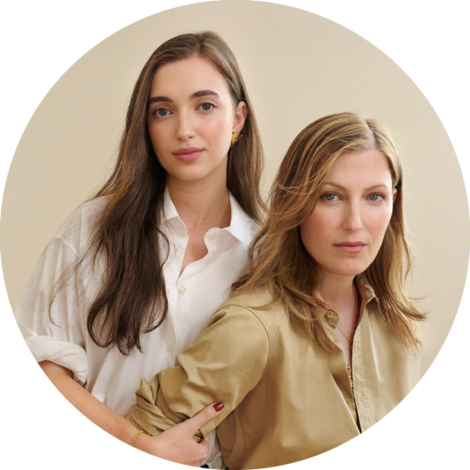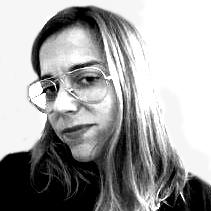Bonnie, one of my best friends, was passing through New York City in 1995 on her way to the South of France to meet with her father. He had long been mostly absent from her life, and she felt that the time had come to establish some kind of real exchange. We sat on my bed and stuck our feet out my fifth-floor window when the rainstorms came, and I tried to send her off with a little more joy in her embattled heart.
In the letters that followed, she told me the dad reunion was a bust. But on the plane, she met a guy who knew a guy with a room to spare in his Paris apartment. She was ready to take a break from San Francisco, so she rented a room from this fellow, Eric, while she decided what she was going to do with her budding adult life. She applied to a Ph.D. program in ethnic studies at U.C. Berkeley, but she wasn’t sure. I’d write back to her about life in New York, and the grind of getting my master’s degree, and I punctuated my missives with little swatches of makeup I managed to afford even though I was broke enough to occasionally skip meals. “Check out this Chanel liquid eyeliner. It’s cake and it comes in: [forest-green stripe] [gasoline-blue stripe]!”
During our long friendship, life has thrown up a lot of complications that we’ve helped each other through. Makeup was one of the simplest things that connected us. We were both in our mid-20s, the age when we finally started to understand how to wear makeup and what it could do. It was a joyful discovery, not bittersweet. There was MAC and Bobbi Brown by then, but we were most fascinated by the European brands. They felt foreign and exotic and sultry.
The apartment situation for Bonnie wasn’t meant to be permanent, but she kept not wanting to go home. She got a part-time job driving a fashion photographer who loved Chet Baker, and little by little things with Eric turned amorous. He started taking her to white-tablecloth dinners for two and bringing home flowers, and she started nesting and cooking for them both. One day he gave her a copy of Le Petit Prince, an allegory about distance and longing and alienation that most French kids know by heart. He wanted her to understand his country, because he was hoping she’d stay. Not long after, he came back from a business trip with another gift: Guerlain’s Les Météorites.

Bonnie wrote me about these tiny balls of iridescent powder in hypnotic sorbet colors rolling loose in a container that looked like a candy box. They smelled like violets. “You’re supposed to kind of buff it into your skin and it glows,” she wrote. Impractical—I mean, what do you do when those balls, each one the mass of an orange seed, spill out? But the folly was kind of the point. This was a product to be applied languorously with a brush while wearing a silk nightgown, seated at a vanity. It was not to be used on the go.
Though always better known for its perfumes, Guerlain has created makeup since the company was founded, in 1828, by the chemist Pierre-François-Pascal Guerlain. After World War II, American G.I.’s were said to line up outside Guerlain’s boutique on the Champs-Élysées to buy perfumes or red lipstick for their sweethearts back home. (My heart warmed when I discovered that our Eric followed in the footsteps of the “greatest generation.”)
During our friendship, makeup was one of the simplest things that connected us.
By the 80s, outside of perfume, Guerlain’s hero product was the Terracotta bronzer. (Today, one is said to be sold every 20 seconds.) Then, on a research visit to China, Dominique Szabo, the company’s creative director of makeup at the time, saw a box of white-powder pearls and got the idea for Les Météorites. Launched in 1987, the highlighting product was successful enough to spawn Les Météorites blushes and bronzers, pressed powders, and a shimmery foundation primer. What unites them all is the interplay of the pastels to create almost any kind of glow.
Eric’s gift may have catalyzed the moment when Bonnie grew up. It propelled her to weigh her heart and her head. Not too long after, she moved from her own bedroom into Eric’s. It wasn’t the box of powder, but what it represented: an offer of wonderment, optimism, indulgence, femininity, preciousness, whimsy. It’s awfully bold for a man to buy a woman makeup; it can go wrong in so many ways. But this man loved her. Just as importantly, he understood her, and this was one of many instances of proof. Bonnie ended up getting into Berkeley, but she was by now much less eager to fly away. Eric sealed it with a simple pitch: “Why read about the world when we can go see it together?” Within a year, they had moved to London, she was pregnant, and they had set a date for the wedding. In the 30-plus years since, they have been around the world together twice.

I wanted what my friend was having. When Bonnie and Eric invited me to their wedding, in their backyard in Holland Park, I met Eric’s business partner, an equally tall, even more openly eccentric fellow. We planted marigolds in the garden together before the ceremony, and by the end of the night, I, who was supposed to be crashing on my friend’s floor, ended up in his hotel room. Could he be my Météorite?
When he came to visit me in New York, the next month, he did not bring powder or philosophical children’s literature. He brought Camembert—which was delicious but stank up my entire apartment—and funny opinions, and also his half of the makings of a zygote. We hardly knew each other, so, predictably, everything went south from there. Reader: I am still childless, and he is now a wealthy businessman and part-time drag queen. No regrets.
It wasn’t the box of powder, but what it represented: an offer of wonderment, optimism, indulgence, femininity, preciousness, whimsy.
Still, I never really lost the taste for a tall Frenchman. In 2006, I went to Paris for an extended hang. Bonnie and Eric had moved back from London, and I was on the phone with her every day and at their table often in those first few months. I liked the way they did things, and I liked the way Paris did things. It was ridiculously pretty, and when its people weren’t incredibly rude, they were magnificently gallant. Anchored by the presence of my dear friend, I bought an apartment—still doable in 2006 as a freelance journalist—set up a life, and went about looking for the next tall, well-mannered one who might come bearing gifts.
I found a few, though none who stuck. In the end, I did better buying my own cosmetics.
Alexandra Marshall is a Writer at Large at AIR MAIL and a contributor to W, The Wall Street Journal, Vogue, and Travel + Leisure. She chronicles her recent relocation to Le Perche in the newsletter An American Who Fled Paris





